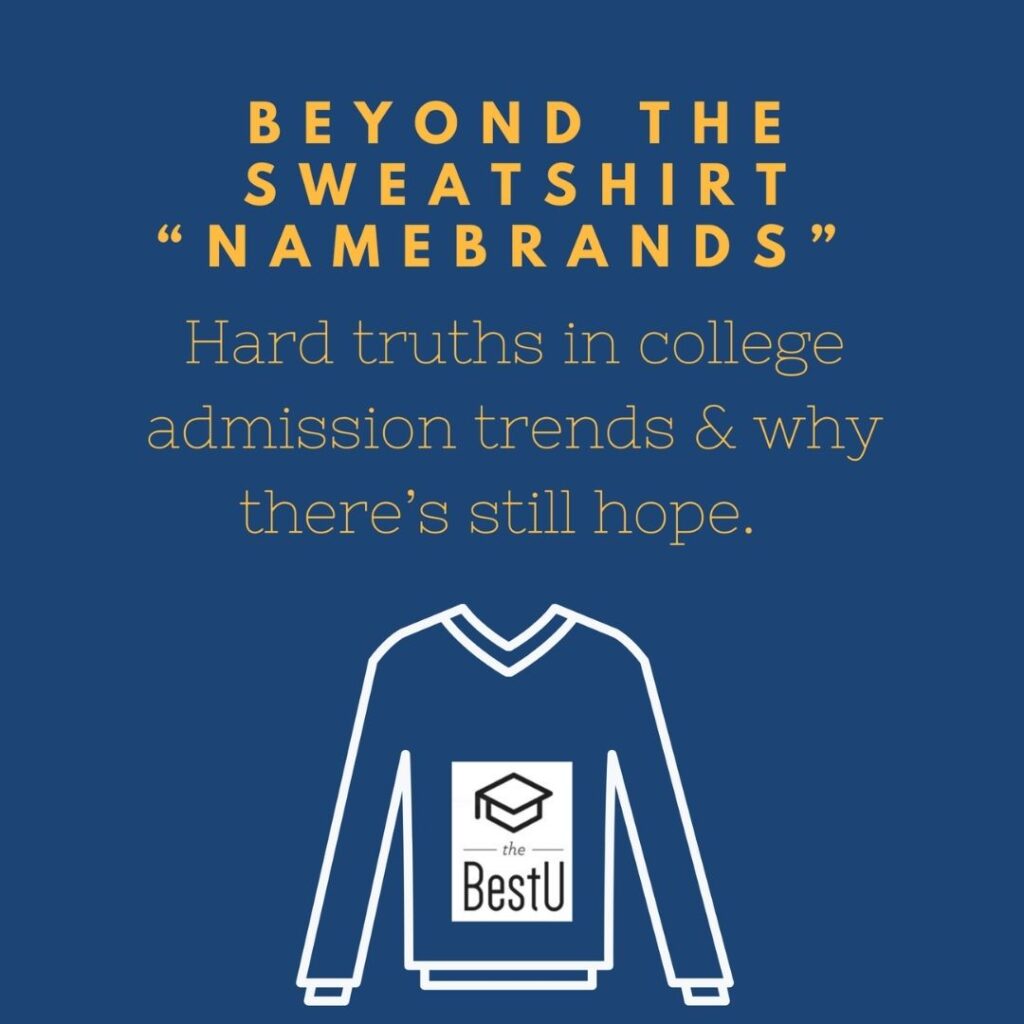
You have probably heard that 2022 has been another ‘record breaking’ year in college admissions. If you are the parent of a student graduating high school in 2023, 2024 or 2025, this is probably causing significant angst and worry as you imagine what the future holds for your children.
The hysteria that surrounds the college admissions process is unhealthy for young people planning the next chapter of their lives, and is fostering a sense of scarcity and desperation, but the challenges are real. Here are three hard truths we think every applicant and their families should know and why we still have hope –
#1 Applicant pools are growing, and acceptance rates are shrinking.
This cannot be overstated. Students intent on applying to the small circle of ivies, highly selective liberal arts colleges, and flagship public universities are facing unprecedented competition as acceptance rates are pressing to single digit lows. Notably, this has increased competition, transforming institutions that may have been previously seen as ‘match’ schools into highly competitive reaches. Recent examples include the 12% acceptance rate at NYU, and the 6.7% acceptance rate at Northeastern University this year.
Why there’s hope–
This phenomenon is actually impacting a relatively narrow group of colleges “at the top” where a lot of media and public attention gets directed. Students who are willing to expand their vision beyond this ‘prestige’ pool and consider colleges they may be less familiar with or had not previously envisioned applying to, will find a rich landscape of colleges that provide excellent resources, opportunities, and thriving campus communities.
What students can do–
Every student, no matter how high their GPA or test scores, should have a range of colleges that are truly likely and possible fits, including those with acceptance rates at and above 50%. This will help to ensure that a student is in the position of having choices come spring of senior year.
#2 Major matters.
Certain popular major choices are experiencing even greater competition than the general applicant pool. This is especially pronounced in business. Students who are interested in one of these high demand fields are likely to find increased scrutiny on their coursework, activities, and testing related to the field. Students are sometimes surprised to learn that highly competitive business programs expect students to have excelled in advanced math courses, scored especially high on the math portions of the SAT or ACT, and have in-depth experiences outside of school related to their interests. This does not mean students should ‘game the system’ by changing from a major they are deeply invested in, but it means all applicants will need to carefully and honestly assess their likelihood of admission to their top choice colleges and programs.
Why there’s hope–
Wharton, Ross, and Stern are not the only places to earn a degree and gain powerful business-related experiences. You’ll sense a theme here, but there are many colleges and universities that will provide excellent business education! Explore the specifics of the program offerings at public universities that might not make top 10 lists, and at smaller to mid-size colleges that have dedicated business curricula.
And guess what? Many graduates have earned liberal arts degrees and gone on to build successful careers in the business world. Liberal arts colleges, by design, will not ask you to declare a major as an applicant. Your admissions readers will always be interested in knowing what subjects you think you would like to study, and what motivates that curiosity, but major will be unlikely to influence admissions decisions at liberal arts colleges.
What students can do–
Students interested in a high-demand major like business, should ensure that they are very strong applicants to their colleges of interest, and have the courses, grades, test scores and activities that will distinguish them at the top of those pools. Students should also diversify their college lists, with universities that have both higher acceptance rates and good business programs. In addition, families can discuss how serious a student’s interest in the chosen major is. If business is a box a student is checking, just because they aren’t sure what else to pick, this is a good opportunity to explore what kinds of questions and topics they may wish to engage in the departments that fall under the Arts & Sciences umbrella at a college of interest.
#3 Early is now the expectation.
Many colleges are accepting 50% or more of their admitted students through binding Early Decision admissions. Case in point? Tulane University. In the 2021 admissions cycle, Tulane reported an overall acceptance rate of 11% (see #1 above!). And yet, if you probe this data, the Early Decision acceptance rate was 23%, the Early Action acceptance rate was 15% and the Regular Decision acceptance rate at Tulane University was…1%. Similar, though slightly less dramatic trends have been evident at flagship public institutions such as University of Virginia and UNC Chapel Hill for out of state applicants. Note that while there are good reasons to apply for non-binding early action deadlines, early action admission does not generally offer the same benefit to applicants as ED admissions, as acceptance rates often remain incredibly competitive in these pools.
Why there’s hope–
This does not mean every student should rush to submit an Early Decision application. ED needs to be the right personal and financial decision for a student and their family; but, for students who are strong applicants to a top-choice college, Early Decision is a strategy that may be worth consideration. Once again, hope lies in the fact that there are so many more fantastic colleges out there that aren’t caught up in this ever increasing competition to lower acceptance rates.
Looking beyond the ‘sweatshirt’ name brands and identifying schools that have the academic programs and campus life that fit a student as an individual will yield many possible colleges to call home. And, although Early Action may not significantly increase a student’s likelihood of admission, it does communicate interest and investment to the college. Sometimes, early action students who are strong in an applicant pool may be offered merit based scholarships to further entice them to enroll.
What students can do–
It is in every student’s best interest to craft strong applications and essays over the summer and to be prepared to apply to several colleges with early action or rolling admission deadlines. This will also help to free up valuable time for academics, activities, friends and family in the busy Fall of 12th grade. Families should seriously consider if ED is right for their student at a top-choice school; but, remember that even with Early Decision, a student needs to be a strong and viable applicant for the college to have a shot in an ED pool.
